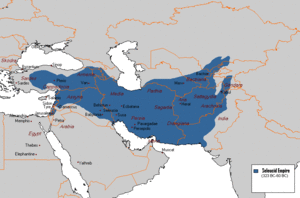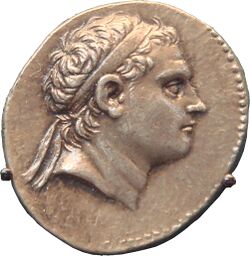How Did Antiochus III Influence the Hellenistic World
The era of Greco-Roman history known as the Hellenistic Period (336-31 BC) is often overlooked and sometimes trivialized by historians and classicists. Some experts argue that the era was lacking in the artistic beauty and cultural significance of the earlier Greek city-state period: most of the great Greek philosophers were pre-Hellenistic and most of what are considered Greece’s finest works of art and architecture were made before 336 BC.
On the other hand, other scholars contend that the Hellenistic Period lacked the geopolitical significance of the Roman Empire because, for instance, Augustus was able to do what no Hellenistic king could by uniting the entire Mediterranean basin under one government. With all of that said, the Hellenistic Period was still a very important part of Greco-Roman culture.
The Hellenistic Period was essentially a bridge that joined the Greeks and Romans into what experts of “big history” refer to as “Hellenic Civilization.” It was a period of turmoil, war, and expansion, when Macedonian Greek kings eschewed democracy but attempted to spread other elements of Greek culture to the east. Among the Hellenistic kings, Antiochus III of the Seleucid Empire was one of the greatest. From his throne in the newly founded city of Seleucia, Antiochus III influenced the greater Hellenistic world by waging wars against Ptolemaic Egypt and Rome and by recognizing the native Babylonian culture, while promoting Hellenism within the kingdom.
Hellenism and the Hellenistic World
In order to understand Antiochus III’s role in the Hellenistic world, a brief examination of Hellenism is warranted. The term is derived from the ancient Greek word for Greece, Hellas, and refers to the philosophy that became popular in the Greek speaking world in the late fourth century BC whereby certain elements of Greek culture were forcefully spread to non-Greek speaking lands in the east. The Hellenistic kings did this a number of ways, including building new cities – Alexandria, Seleucia, Antioch, etc. – and by forcefully moving as many as hundreds of thousands Greek speaking migrants into the Near East. [1] But Hellenism would have only been a high-minded philosophy discussed in the academies of Greece if it were not for Alexander the Great and his successor generals who spread the idea by force.
The Seleucid Empire
After Alexander died in 323 BC, his vast empire was divided among his Macedonian generals who were known as the Diadochi. Disagreements over succession were immediately apparent, so the generals met in a city called Triparadeisos, Syria in 320 BC in order to reach an amicable settlement. Although the agreement led to civil war among the Macedonians, which are known as the Wars of the Diadochi, a general named Seleucus walked away with the Babylonian “satrapy,” which comprised all of Mesopotamia, part of the Levant, and most of Persia. [2]
Seleucus established a new Macedonian dynasty in Mesopotamia, known as the Seleucid Dynasty, and officially assumed the kingship in 305 BC, becoming the new king of Babylon. Seleucus, who is now known as Seleucus I (ruled 305-281 BC), established many of the hallmarks of Seleucid culture and created a template for later kings, such as Antiochus III, during his long and prosperous rule. Although he was a proponent of Hellenism, settling thousands of Greek speaking migrants in Mesopotamia during his rule, he also tolerated and even supported the native Mesopotamian culture to some extent. He commissioned Babylonian scholars to include the early Seleucid kings in the Babylonian Chronicle and they were also included in the Uruk King-lists through the reign of Seleucid II (reigned 246-225 BC). In addition, Seleucus I observed the important Babylonian New Year festival, which no doubt helped to further ingratiate his rule and his new dynasty among the influential native Babylonian priests. [3]
Antiochus III in Power
When Antiochus III (ruled 223-187 BC) came to power, he had the benefit of inheriting a fairly stable and prosperous kingdom. With that said, the rule of Antiochus III “Megas,” or “the Great,” represented the apex of Seleucid power – the empire stretched to its farthest extent and the kings commanded the respect of rulers from Rome to India. It would be on the battlefield where Antiochus III would have the greatest impact in the Hellenistic world, although he was not always successful.
Not long after Antiochus III came to power, he was challenged by one of his regional governors, or “satraps,” named Molon. Perhaps believing that the new king was naïve and inexperienced, Molon led a rebellion in his satrap of Media. Antiochus III, though, proved to the other Seleucid satraps that he was not to be challenged, as he quickly put the rebellion down and executed Molon. [4] But Antiochus had little time to enjoy his victory because an older and more powerful enemy was causing problems in the west.
The Fourth and Fifth Syrian Wars
Perhaps the greatest enemy that the Seleucids had was another Macedonian descended dynasty – the Ptolemies of Egypt. The Seleucids and Ptolemies fought six major wars, known as the Syrian Wars, against each other for control of the region they knew as “Coele-Syria,” which was the inland region of the Levant, not including Judea. Four wars had already taken place between the Ptolemies and Seleucids by the time Antiochus III came to the throne, usually with very little change in the geopolitical map, but the upstart Seleucid king believed that he could easily defeat Ptolemy IV (reigned 221-204 BC). The Fourth Syrian War lasted from 219 BC until 217 BC, ending in dramatic fashion at the Battle of Raphia on June 22, 217 BC. All expected Antiochus III to win the war, but Ptolemy IV pulled out the upset, routing the Seleucid forces. The victory was only temporary, though, as native Egyptian military officers aligned with native Egyptian priests fomented a rebellion in order to overthrow the Ptolemies. [5] The Ptolemies were able to suppress the native rebellion and hold Coele-Syria, which meant that Antiochus III had to switch his tactics from military force to diplomacy.

Most successful rulers show their true acumen as a leader during peacetime and in the art of diplomacy. Any king with a large enough army can win battles, but it takes a certain amount of cunning and intelligence to be able to negotiate beneficial deals during peacetime and arrange alliances that can put one in a more stable position when war does resume. Antiochus III did this by arranging the marriage of his daughter to the next king of Egypt, Ptolemy V (ruled 204-180 BC). The marriage temporarily brought peace to the two kingdoms, but Antiochus III merely used the respite to consolidate his forces and prepare for a surprise attack in Coele-Syria.
Antiochus III proved to be much more successful in the Fifth Syrian War (202-195 BC) than he was in the previous installment, as he not only retook Coele-Syria but also added Phoenicia, coastal Palestine, and Judea to the Seleucid possessions. [6] Antiochus was partially aided by severe inflation in Egypt, [7] but the battlefield victory was nonetheless total and complete. Antiochus III’s victory over Ptolemy V made him the most powerful monarch of the Near East and arguably also the strongest among the Hellenistic kings. But the Seleucid king’s new won status also pulled him into a war with Rome that proved to be the beginning of the end of the Seleucid Empire.
The Roman-Seleucid War
War was a constant state of affairs during the Hellenistic Period among the Macedonian descended rulers, but by the early second century BC the Romans entered the mix. Since Macedonia was the ancestral homeland of all the Hellenistic kings, they often set their sights on conquering the land in addition to whatever empire they ruled. Macedonia was also close to Rome, which had been expanding steadily in the western Mediterranean and was fresh off its decisive victory over Carthage in 202 BC. In 193 BC, Antiochus III decided to invade Philip V’s (reigned 221-179 BC) Kingdom of Macedonia, but was ultimately challenged by the Romans. At first, the Romans were cautious of Antiochus’ power and aligned with him:
“With affairs in this disturbed state, the Romans had no hope of overcoming Antiochus, but were content if only could preserve their former conquests. For he was regarded as a mighty ruler even by virtue of his own power, by which he had subjugated Media among other exploits; but he became far mightier still through having gained as sons-in-law Ptolemy, king of Egypt, and Ariarathes, king of Cappadocia. In view of this estimate of Antiochus, the Romans, so long as they were at war with Phillip, were careful to court his favour, keeping up friendly relations with him through envoys and sending him gifts. But when they had vanquished their other enemy, they despised also this king whom they had formerly feared.” [8]
The Romans’ opportunity to turn on the Seleucids came when Eumenes II, the king of Pergamum, offered his army in an alliance against Antiochus III. The Roman-Pergamum army routed the Seleucids at the Battle of Magnesia in late 190 or early 189 BC. Although Antiochus III did not relinquish any Seleucid lands to the Romans, he was forced to send royal hostages to Rome and to pay a large indemnity, setting the stage for the Seleucid twilight and Rome’s dominance in the eastern Mediterranean. [9]
Antiochus III, Hellenism, and the Native Babylonian Religion
The final way in which Antiochus III influenced the Hellenistic Period was his nurturing of the Greek and Babylonian cultures within his kingdom, often simultaneously. Although he did not take the active role promoting Babylonian historiography the way that the first two Seleucid kings did, he was known to play a role in the important Babylonian New Year festivals. [10] While he was doing that, Antiochus III also promoted Hellenism in Mesopotamia by building gymnasions and almost exclusively promoting Greek speakers within the royal administration. [11]
Conclusion
Antiochus III played a major role in the history of the Hellenistic world. He ruled the Seleucid Empire when it was at its greatest point in terms of physical extent, wealthy, and power, gaining the respect of the other powerful leaders of the world through his military prowess. Antiochus III battled the Ptolemies, eventually taking considerable land from them in the Levant, but was ultimately stopped short in his conquest of the Mediterranean by the Romans. The Seleucid king was also a supporter of the cultures of both his Greek and Mesopotamian subjects, which helped make him one of the more interesting and important of all the Hellenistic kings.
References
- Jump up ↑ Bryce, Trevor. Ancient Syria: A Three Thousand Year History. (Oxford: Oxford University Press, 2014), p. 168
- Jump up ↑ Bryce, pgs. 159-161
- Jump up ↑ Boiy, Tom. “The Reigns of the Seleucid Kings According to the Babylonian King List.” Journal of Near Eastern Studies 70 (2011) pgs. 1-10
- Jump up ↑ Bryce, p. 182
- Jump up ↑ Chauveau, Michael. Egypt in the Age of Cleopatra: History and Society under the Ptolemies. Translated by David Lorton. (Ithaca, New York: Cornell University Press, 2000), p. 11
- Jump up ↑ Bryce, p. 187
- Jump up ↑ Chauveau, p. 84
- Jump up ↑ Cassius Dio. Roman History. Translated by Earnest Cary. (Cambridge, Massachusetts: Harvard University Press, 1954), XIX, 9, 18
- Jump up ↑ Bryce, p. 190
- Jump up ↑ Boiy, p. 11
- Jump up ↑ Price, Simon. “The History of the Hellenistic Period.” In The Oxford History of Greece and the Hellenistic World. Edited by John Boardman, Jasper Griffin, and Oswyn Murray. (Oxford: Oxford University Press, 2001), pgs. 370-5



